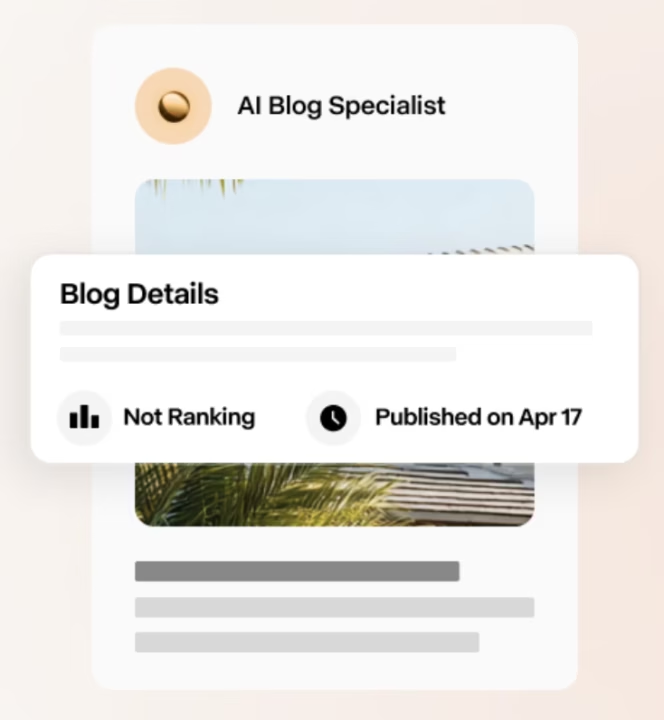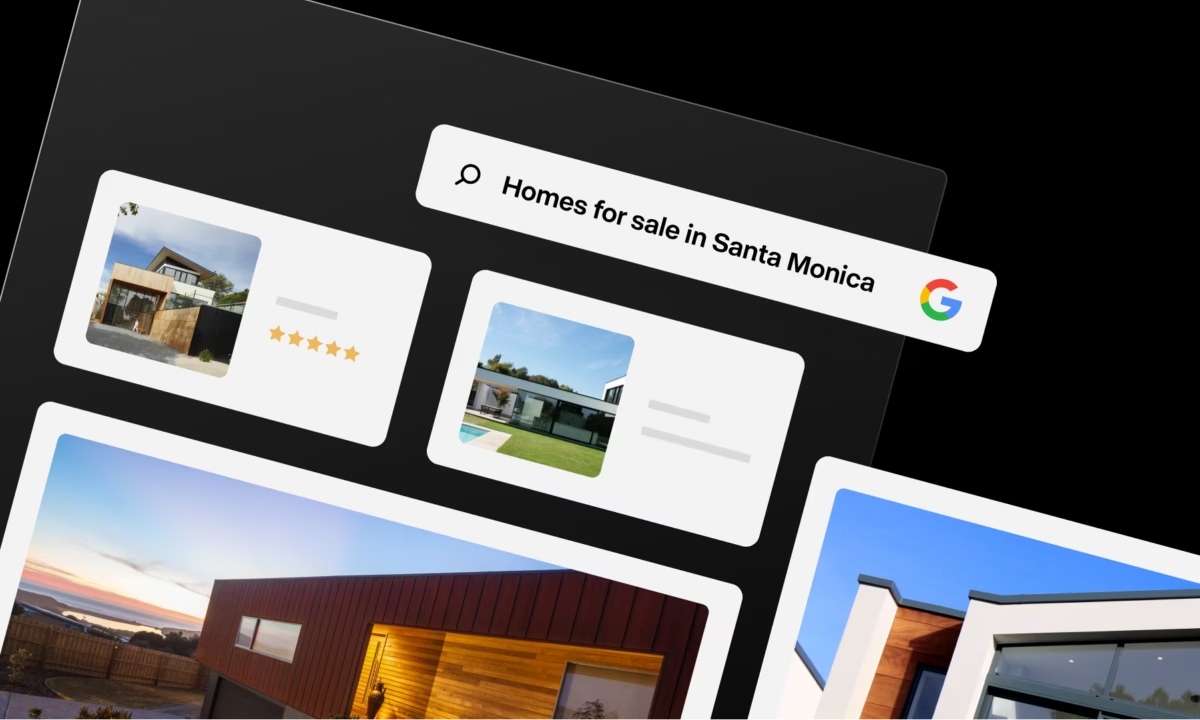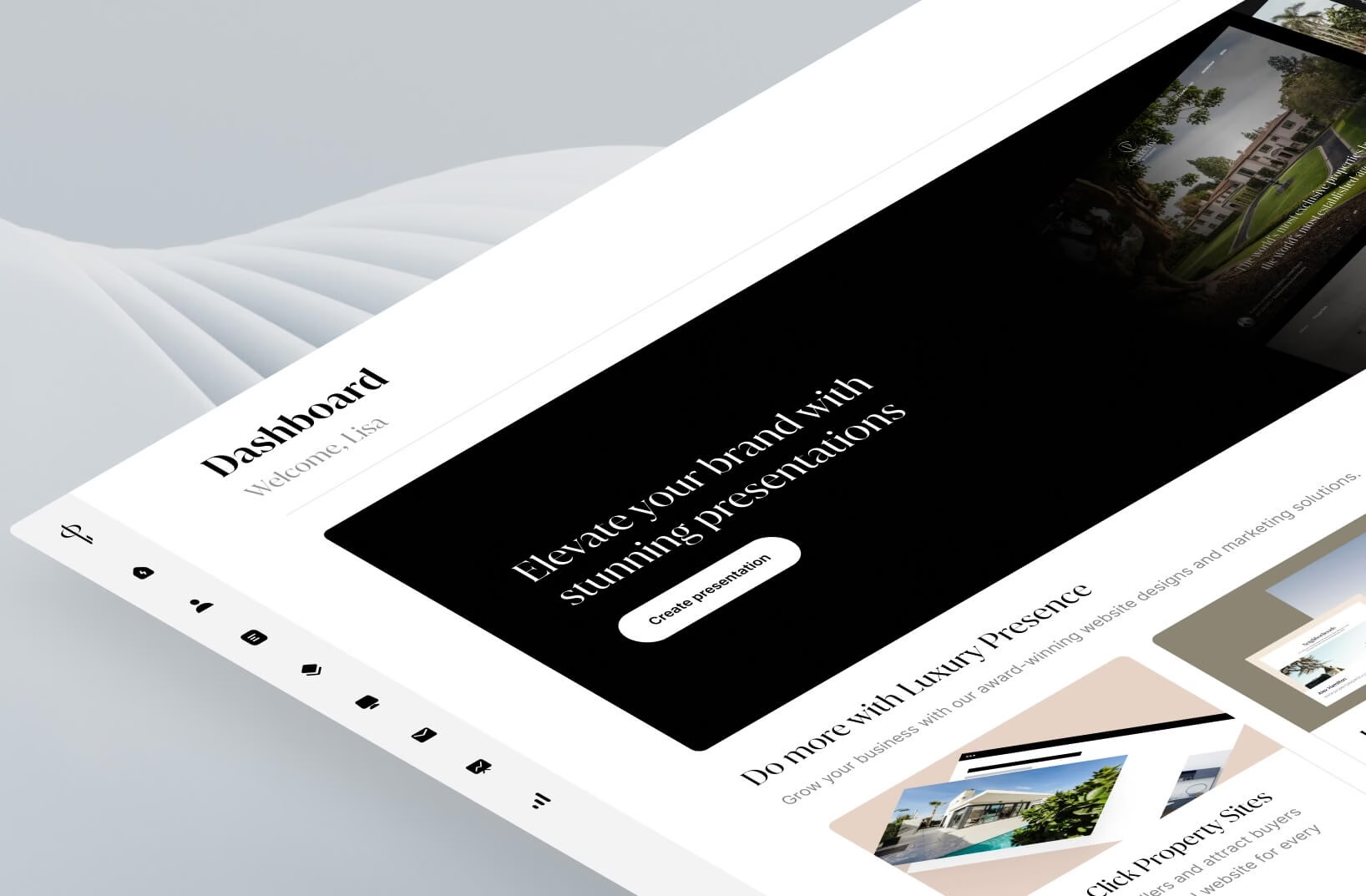
A real estate blog is a dedicated online space where agents share market insights, homebuying tips, and local expertise to engage potential clients and build trust. It’s both a marketing tool and a resource for showcasing your knowledge and staying connected with your community.
In this guide, we’ll walk you through how to start a real estate blog, covering how to plan, create, and maintain one that drives traffic, strengthens your brand, and helps you grow your business.
Find It Fast
Does a real estate blog still matter in 2025?
Yes. Your real estate blog is one of the few marketing channels you fully own and control, making it a powerful long-term asset for your business.
Here’s why blogging remains essential in today’s landscape:
- Boosts visibility in traditional and AI search
Search engines still reward consistent, high-quality content. With the right keyword strategy, a blog can put your website in front of motivated buyers and sellers at the exact moment they’re looking for answers, driving organic traffic and high-intent leads directly to you. - Builds trust through thought leadership
Clients expect more than property photos; they want expertise. A well-crafted blog helps you demonstrate deep market knowledge, showcase success stories, and share valuable tips that establish you as a trusted advisor, not just another agent. - Supports every other marketing channel
Blog content can be repurposed across multiple platforms, from Instagram carousels to YouTube scripts to email newsletters, giving you a consistent stream of marketing material without starting from scratch each time. - Leverages AI for faster, smarter creation
Thanks to tools like Luxury Presence’s AI Marketing Blog Specialist, you can now generate ideas, draft SEO-optimized content, and tailor posts for different audiences in a fraction of the time it once took. This means you stay consistent and competitive without sacrificing quality or spending hours writing.
Simply put, a blog is the foundation for sustainable growth. By combining your unique insights with AI-driven efficiency, you can create a content engine that attracts leads, strengthens your brand, and keeps you ahead of the curve in today’s evolving market.
Meet your new content partner: The AI Marketing Blog Specialist
Creating consistent, high-quality blog content takes time and focus, two things most real estate professionals don’t have to spare. The AI Marketing Blog Specialist takes this work off your plate by handling topic selection, SEO optimization, and publishing, keeping your blog active and effective without adding to your workload.
Here’s what the AI Marketing Blog Specialist delivers:
- Smart topic generation: Automatically selects topics based on your preferred locations and keyword opportunities to ensure your content is relevant and highly searchable.
- SEO optimization built-in: Generates keyword-rich titles, meta descriptions, and structured headings to help every post rank on search engines from day one.
- Consistent content calendar: Provides a steady stream of ready-to-publish, search-optimized posts so you always have fresh, engaging content going live.
One of the most powerful aspects of this system is that it continuously learns and improves over time. Built on Presence AI, the technology behind the specialist studies patterns across thousands of real estate blogs in the network.
This means that every blog it produces benefits from collective insights, like which topics perform best, how search algorithms are evolving, and what styles of writing engage readers most effectively. The more you use it, the smarter and more tailored it becomes, giving you an ever-improving content strategy without extra effort on your part.
AI Blog Specialist
Effortlessly attract and engage clients with AI-powered blog content tailored to grow your business.

How to start a real estate blog in 6 steps
If you don’t have a blog, getting started with clear, manageable steps allows you to go from idea to launch quickly, and set yourself up with a content hub that attracts clients, boosts your SEO, and grows your brand for years to come.
Choose your provider
If you already have a Luxury Presence website, you’re ahead of the game. Our websites are already designed to feature blogs and have the technical specs to help it be successful.
If you are with another provider, research the company’s integrations, reliability, security, and customer support options. Many hosting providers offer easy, one-click installations for common blog providers.
Technical specifications for your blog
To ensure your blog performs well, ranks in search engines, and provides a seamless experience for visitors, make sure it meets these core technical requirements:
- Mobile-first, responsive design: Ensure the blog works seamlessly on smartphones and tablets.
- Fast load speed (under 3 seconds): Optimize images and hosting to improve user experience and search rankings.
- SEO-friendly setup: Clean URLs, meta tags, alt text, and schema markup to help search engines index content effectively.
- Easy-to-use content management system (CMS): Use a platform like WordPress or Webflow to simplify publishing and editing.
- Internal linking structure: Support topic clusters and cross-linking for better SEO and navigation.
- Analytics integration: Connect Google Analytics and Search Console to track performance and user behavior.
Choose a domain name that reflects your brand and is easy to remember. Then select a professional and visually appealing theme or template for your blog. Customize the design to match your brand identity, including colors, fonts, and logos.
Define your audience
Before you come up with topics to cover, you need to identify and understand the specific group of people you want to reach with your content.
Here are the key elements to define to know your audience.
Demographics
This means understanding the basic characteristics of your audience, such as age, gender, income level, occupation, and location. For example, your audience might consist of first-time homebuyers in their 30s living in urban areas. This doesn’t mean your content won’t resonate with other groups, but if you try to write for everyone, you’ll end up writing for no one.
Behavioral patterns
Analyze the online behavior and habits of your audience, focusing on where they spend their time digitally, the platforms they engage with most, and how they prefer to consume information, such as videos, blog posts, or social media updates.
Look at the types of content they interact with, the times they are most active online, and the digital touchpoints that influence their decisions. While offline factors like community events or in-person interactions still play a role, understanding these online patterns is critical for tailoring your content distribution and marketing strategies effectively.
Real estate needs and preferences
Consider the specific real estate needs, challenges, and preferences of your audience. This includes their housing preferences, buying or selling timeline, budget constraints, and desired amenities or features in a property. By addressing these factors in your content, you can provide valuable guidance and solutions to your audience’s real estate concerns.
Local market considerations
Recognize the unique characteristics and dynamics of your local real estate market and how they impact your audience. This involves staying informed about market trends, neighborhood developments, school districts, transportation options, and other factors that influence buying and selling decisions in your area.
Plan your content strategy
By planning and organizing content around your audience’s needs and preferences, you can provide valuable information, showcase expertise, and build trust, ultimately leading to increased brand awareness, lead generation, and client retention.
Here are the key steps to take before you even start writing:
- Conduct keyword research to identify popular search terms and topics relevant to the target audience and local market. Focus on topics that align with your expertise and address common questions or concerns.
- Develop a content calendar outlining the topics, formats, and publishing schedule for blog posts. Consider your audience’s behavior patterns, seasonal trends, local events, and industry updates when planning content. The first step is to develop monthly themes with 15-20 specific post ideas per month.
- Plan for a mix of content types to keep the blog interesting and engaging. This could include informative articles, market updates, neighborhood spotlights, homebuyer and seller guides, case studies, success stories, and multimedia content like videos and infographics. Provide practical tips, expert advice, insider insights, and actionable strategies that help buyers and sellers navigate the real estate process.
- Ensure that blog posts are designed for SEO by using relevant keywords, writing compelling meta titles and descriptions, and structuring content for readability and SEO best practices.
Craft compelling content
Focus on educating and informing your audience by addressing specific questions, debunking myths, and providing in-depth, expert analysis of real estate topics.
Incorporating visual elements such as photos, videos, and infographics enhances content and captures your readers’ attention.
Ensure it’s free of all spelling and grammatical errors, as your content is a reflection of your overall personal brand.
Include a call to action (CTA) that compels your audience to book an appointment, schedule a showing, or fill out a contact form. The action can change based on the content, but make sure there are clear directives that indicate what you want your audience to do next.
Organize your content
To build long-term visibility and drive consistent traffic, it’s essential to have a clear content organization strategy. By structuring your content around core topics, you can strengthen SEO performance, create a seamless user experience, and make your production process more efficient. Below are key strategies to consider:
Pillar page strategy
Create comprehensive, in-depth guides that cover a core topic and connect to related blog posts. A strong pillar page helps your blog rank for multiple related keywords while positioning your site as an authority on key real estate topics.
How to implement it:
- Identify cornerstone topics that align with your business goals, such as:
- Buying a Luxury Home
- Selling a Home in [City]
- Luxury Home Staging
- Write a detailed pillar page (typically 2,500–5,000 words) that fully addresses the topic.
- Link to supporting content, such as neighborhood guides, market reports, or niche blog posts that explore subtopics in more depth.
- Ensure all supporting pages link back to the pillar page to strengthen your internal SEO structure.
Topic clustering
Topic clustering involves organizing related content around that single pillar page to build SEO authority and show search engines that your site is a trusted, well-structured resource.
How to implement it:
- Choose a pillar topic, such as Real Estate Investment Strategies.
- Create related blog posts that dive into specific subtopics, like:
- Tax Benefits of Real Estate Investing
- How to Analyze Rental Properties
- Link each subtopic article to the main pillar page and to other related posts to form a network of interconnected, high-value content.
- Use your content calendar to visualize clusters and track how each piece supports your overall SEO strategy.
Content repurposing workflows
Content repurposing allows you to take one high-performing piece and transform it into multiple formats for different platforms. This maximizes both reach and return on investment.
How to implement it:
- Start with a detailed blog post or market report.
- Break it into smaller, targeted assets, such as:
- Three social media posts for Instagram, LinkedIn, and Facebook
- A short video or Reel
- An infographic or data visualization
- A newsletter segment for your email list
- Two to three shorter blog posts or supporting pieces
- Extract key snippets to optimize for AI-driven search results, like FAQs or definitions, which can boost visibility in tools like ChatGPT or Google’s AI overviews.
- Schedule repurposed content over several weeks to maintain consistency and maximize exposure.
Use a project management tool like Trello or Notion to track content formats, publication dates, and platform distribution, ensuring nothing falls through the cracks.
Promote your blog

Real estate agents can promote their blog through various channels and strategies to increase visibility, attract readers, and drive traffic.
- Share blog posts on social media platforms such as Facebook, LinkedIn, and Instagram. Use engaging visuals, compelling captions, relevant hashtags, and CTAs to encourage followers to read and share blog content.
- Include links to blog posts in the email newsletters you send to clients, prospects, and your sphere. Use enticing subject lines and preview text to pique interest and drive clicks to your blog.
- Partner with other professionals, such as mortgage brokers, home inspectors, or interior designers, to cross-promote each other’s blog content. This expands reach and exposes your real estate blog content to a wider audience.
- Write guest blog posts for other real estate websites, industry publications, or local news outlets. Include a bio and link back to your blog to drive traffic and establish credibility.
- Promote your blog during networking events, industry conferences, and community gatherings. Add the URL to your business cards so that it’s easy for attendees to visit and subscribe.
- Consider investing in paid advertising channels such as Google Ads or Meta Ads Manager to promote blog content to a targeted audience. Set specific targeting criteria to reach potential clients and drive traffic to your blog.
- Participate in online forums, discussion groups, and community threads related to real estate or local neighborhoods. Share helpful insights, answer questions, and include links to relevant blog posts when appropriate.
- Engage your audience by encouraging comments, questions, and feedback on your blog, and respond promptly to foster conversation and build trust. Enhance interaction with polls, quizzes, and live events like Q&As or webinars to create a sense of community and gather valuable insights.
By implementing these promotion strategies, agents can effectively increase the visibility and reach of their real estate blogs and attract more readers.
How to measure the success of your real estate blog
To grow your audience and generate qualified leads, you need to track performance consistently and use that data to refine your content strategy. AI-powered analytics tools now make it easier to monitor key metrics, identify patterns, and optimize your blog for better results.
Here are the most important metrics to track and how AI can help you analyze them:
Page views: The total number of times your blog pages have been viewed.
- Why it matters: Indicates overall traffic and visibility
- Industry benchmarks: Small to mid-size blogs: 5,000 – 15,000 monthly page views; High-performing real estate blogs: 30,000+ monthly page views
- AI insight: Segment data by topic or audience type to see which content attracts the most attention.
Average time on page: The average amount of time visitors spend reading your content.
- Why it matters: Longer time on page suggests strong interest and value.
- Industry benchmarks: Strong performance: 1:30 – 2:00 minutes; Needs improvement: Under 1 minute.
- AI insight: Highlight sections where readers drop off and refine those areas for better retention.
Bounce rate: The percentage of visitors who leave after viewing only one page.
- Why it matters: A low bounce rate indicates that readers are exploring more content.
- Industry benchmarks: Good: 30–50%; Average: 50–70%; Poor: 70%+
- AI insight: Analyze content structure and internal linking strategies to improve engagement.
Conversion rate: The percentage of visitors who complete a key action, such as signing up for a newsletter or scheduling a consultation.
- Why it matters: Directly connects blog activity to lead generation.
- Industry benchmarks: General content marketing: 2–5%; High-performing real estate websites: 5–10%
- AI insight: Evaluate calls-to-action and identify which ones drive the most conversions.
Search engine rankings: Your blog’s position in search results for targeted keywords.
- Why it matters: Higher rankings bring in more organic traffic and qualified leads.
- Industry benchmarks: Aim to rank in the top 3 positions for core keywords; CTR by position: #1: ~27%, #2: ~16%, #3: ~11%
- AI insight: Identify keyword gaps and generate optimized content recommendations.
AI and LLM visibility: Tracks whether your blog content appears in AI-generated answers on platforms like ChatGPT, Google Gemini, or Perplexity.
- Why it matters: Inclusion in AI-driven search results positions you as a trusted source and can drive qualified traffic back to your site.
- Industry benchmarks: Emerging metric so no universal standard yet; Goal: Track year-over-year growth in AI-referred traffic and mentions
- AI insight: Monitor mentions of your content, track referral traffic from AI search tools, and identify which topics are most often surfaced so you can create more content in those areas.
Social engagement: The level of interaction with your content on social media platforms, including likes, shares, and comments.
- Why it matters: Reflects how well your content resonates with audiences.
- Industry benchmarks: Facebook: 0.5% – 1% engagement rate; Instagram: 1% – 3% engagement rate; LinkedIn: 0.35% – 0.8% engagement rate
- AI insight: Track which formats and topics perform best to inform future posts.
Referral traffic: The volume of visitors coming from other websites, social platforms, or email campaigns.
- Why it matters: Shows which channels are most effective at driving traffic.
- Industry benchmarks: Blogs with active partnerships: 15–25% of total traffic from referrals; Average blogs: 5–10% from referrals
- AI insight: Identify which referral sources generate the highest-quality leads.
Lead generation: The number of leads and closed deals originating from blog-driven traffic.
- Why it matters: Provides a clear measure of ROI for blogging efforts.
- Industry benchmarks: 2–5% of leads convert into active clients; 0.5–1% may convert into closed deals
- AI insight: Attribute leads to specific blog posts and replicate successful content.
Subscriber growth: The increase in blog or email subscribers over time.
- Why it matters: A growing subscriber base indicates rising interest and trust.
- Industry benchmarks: Healthy growth rate: 3–5% monthly increase; Strong performance: 8%+ monthly increase
- AI insight: Forecast growth trends and refine retention strategies.
Mastering the real estate blog + Luxury Presence
Your blog has the power to attract clients, build trust, and generate leads, but only if it’s consistent, optimized, and aligned with your business goals. With the AI Marketing Blog Specialist, you don’t have to do it all yourself.
Start publishing high-quality, search-optimized content on autopilot and free up your time to focus on what you do best: Serving your clients.
Schedule a demo today and see how the AI Marketing Blog Specialist can transform your blog into a hands-off, lead-generating machine.
Get the platform that drives results.
Agents using Luxury Presence grew sales nearly 2x faster than their peers, increased sold listings by 6%, and closed over $300B in transactions. Ready to grow your business? Let us show you how.




